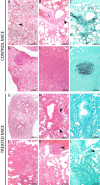A Novel Polyaminocarboxylate Compound To Treat Murine Pulmonary Aspergillosis by Interfering with Zinc Metabolism
- PMID: 29632009
- PMCID: PMC5971598
- DOI: 10.1128/AAC.02510-17
A Novel Polyaminocarboxylate Compound To Treat Murine Pulmonary Aspergillosis by Interfering with Zinc Metabolism
Abstract
Aspergillus fumigatus can cause pulmonary aspergillosis in immunocompromised patients and is associated with a high mortality rate due to a lack of reliable treatment options. This opportunistic pathogen requires zinc in order to grow and cause disease. Novel compounds that interfere with fungal zinc metabolism may therefore be of therapeutic interest. We screened chemical libraries containing 59,223 small molecules using a resazurin assay that compared their effects on an A. fumigatus wild-type strain grown under zinc-limiting conditions and on a zinc transporter knockout strain grown under zinc-replete conditions to identify compounds affecting zinc metabolism. After a first screen, 116 molecules were selected whose inhibitory effects on fungal growth were further tested by using luminescence assays and hyphal length measurements to confirm their activity, as well as by toxicity assays on HeLa cells and mice. Six compounds were selected following a rescreening, of which two were pyrazolones, two were porphyrins, and two were polyaminocarboxylates. All three groups showed good in vitro activity, but only one of the polyaminocarboxylates was able to significantly improve the survival of immunosuppressed mice suffering from pulmonary aspergillosis. This two-tier screening approach led us to the identification of a novel small molecule with in vivo fungicidal effects and low murine toxicity that may lead to the development of new treatment options for fungal infections by administration of this compound either as a monotherapy or as part of a combination therapy.
Keywords: Aspergillus fumigatus; animal models; antifungal agents; antifungal susceptibility testing; aspergillosis; bioluminescence; drug screening; fungal infection; immunosuppression; zinc metabolism.
Copyright © 2018 American Society for Microbiology.
Figures






Similar articles
-
Administration of Zinc Chelators Improves Survival of Mice Infected with Aspergillus fumigatus both in Monotherapy and in Combination with Caspofungin.Antimicrob Agents Chemother. 2016 Sep 23;60(10):5631-9. doi: 10.1128/AAC.00324-16. Print 2016 Oct. Antimicrob Agents Chemother. 2016. PMID: 27401578 Free PMC article.
-
Evaluation of the efficacy of a posaconazole and anidulafungin combination in a murine model of pulmonary aspergillosis due to infection with Aspergillus fumigatus.Diagn Microbiol Infect Dis. 2018 Jan;90(1):40-43. doi: 10.1016/j.diagmicrobio.2017.10.004. Epub 2017 Oct 12. Diagn Microbiol Infect Dis. 2018. PMID: 29126660
-
A Murine Model for Chronic A. fumigatus Airway Infections.Methods Mol Biol. 2021;2260:215-224. doi: 10.1007/978-1-0716-1182-1_15. Methods Mol Biol. 2021. PMID: 33405041
-
Azole Resistance in Aspergillus fumigatus in Patients with Cystic Fibrosis: A Matter of Concern?Mycopathologia. 2018 Feb;183(1):151-160. doi: 10.1007/s11046-017-0162-4. Epub 2017 Jun 26. Mycopathologia. 2018. PMID: 28653258 Review.
-
Exploring azole antifungal drug resistance in Aspergillus fumigatus with special reference to resistance mechanisms.Future Microbiol. 2014;9(5):697-711. doi: 10.2217/fmb.14.27. Future Microbiol. 2014. PMID: 24957095 Review.
Cited by
-
Aspergillus fumigatus and Aspergillosis in 2019.Clin Microbiol Rev. 2019 Nov 13;33(1):e00140-18. doi: 10.1128/CMR.00140-18. Print 2019 Dec 18. Clin Microbiol Rev. 2019. PMID: 31722890 Free PMC article. Review.
-
Proteasome inhibition as a therapeutic target for the fungal pathogen Cryptococcus neoformans.Microbiol Spectr. 2023 Sep 26;11(5):e0190423. doi: 10.1128/spectrum.01904-23. Online ahead of print. Microbiol Spectr. 2023. PMID: 37750732 Free PMC article.
References
Publication types
MeSH terms
Substances
LinkOut - more resources
Full Text Sources
Other Literature Sources

